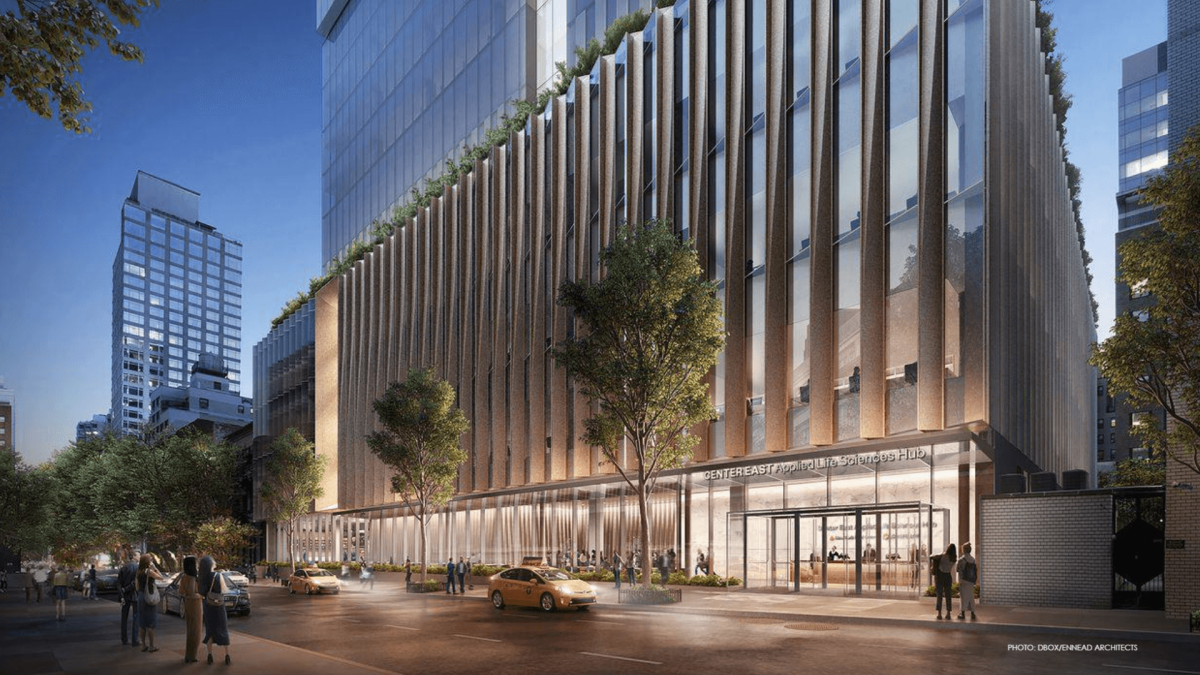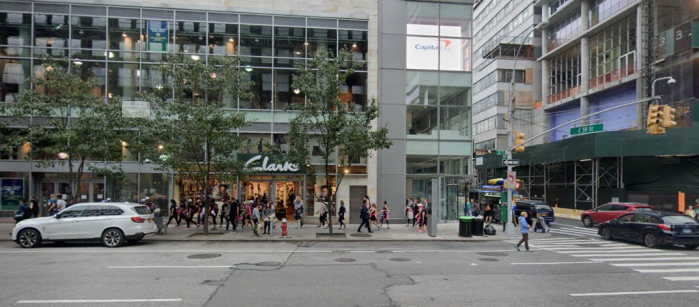Residents from the Upper East Side have come together to speak out against the New York Blood Center’s plan for their new building.
The New York Blood Center is in development to create a Life Sciences Hub on their existing site at 310 East 67th Street in Manhattan, Community District 8. The project will consist of demolishing their headquarters on the Upper East Side and rebuilding it as a 16-floor tower. To start this process, an amendment must be made with NYC Planning in regards to rezoning.
“This rezoning will not only enable the Blood Center to significantly expand its life-saving work, but allow for the development of a state-of-the-art life science campus located in the heart of the Upper East Side’s world class cluster of health care and research institutions,” said Rob Purvis, NYBC’s Executive Vice President and Chief of Staff. “Anchored by the Blood Center, Center East will provide space where research institutions and innovative biotechnology companies can work collaboratively under one roof to advance drug development and cures for diseases.”
NYBC announced its plans for the Center East facility in August of 2020. On Feb. 23, 2021, the NYBC posted an update to the project on their website, explaining that planning will continue throughout the year.
“The proposed renovations will turn the building into a state-of-the-art facility, becoming the heart of New York City’s life science innovation ecosystem and a key part of the city’s pandemic response infrastructure,” said the article on the NYBC website. “The purpose-built, 596,000 gross-square foot campus will modernize NYBCe from the ground up and maximize the building’s impact by creating space for an ecosystem with institutions and startups all working together under one roof.”
NYBC selected life science developer Longfellow Real Estate Partners as its strategic development partner for the facility.
The environmental impact
The proposed plan first required several actions from the NYC Department of City Planning. After reviewing the project, the City Planning Commission determined that the NYBC’s proposed renovations may have a significant effect on the environment. Under the City Environmental Quality Review, a Positive Declaration was issued as well as an Environmental Assessment Statement detailing the possible adverse effects on the environment. The NYBC was to prepare a Draft Environmental Impact Statement.
An Environmental Impact Statement Public Scoping Meeting was held in December. Olga Abinader, Director of the Environmental Assessment and Review Division of the NYC Department of City Planning, chaired the meeting and was joined by several of her colleagues from the Department of City Planning.
“Together, we are here to receive your comments on the Draft Scope of Work for the Draft Environmental Impact Statement, or DEIS, for the New York Blood Center – Center East proposal,” said Abinader in the scoping presentation. “The purpose of today’s scoping meeting is to allow for public participation in the preparation of the DEIS at the earliest stage possible.”
The final scope of work for the issued Environmental Impact Statement is yet to be completed.
The response
Since the proposal and the question of the possible environmental impact, the project has garnered attention regarding the possible effects on the community’s safety, the environment and on the visual aesthetic of the Upper East Side.
On their website, the Friends of the Upper East Side Historic Districts organization said that through the proposed rezoning, the NYBC wants to “undo the R8B contextual zoning which has protected and preserved the special low-rise character of the Upper East Side side streets for decades, since it was mapped in the 1980s as one of FRIENDS’ founders earliest efforts.”
In February, a new, public community group entitled Eastsiders for Responsible Zoning released a statement in response to NYBC’s recent post about their plan for the Center East facility.
“The fact is no need exists for such an out of scale development to empower NYBC to fulfill its mission,” the group said in the statement. “Existing zoning gives the Blood Center everything it needs to modernize and expand its existing facility to a state of the art, world class life science facility, while not adversely impacting surrounding residences, St. Catherine’s Park and the Julia Richman Education Complex.”
ERZ group and community member Bill Angelos expressed his worry not only about the tower’s environmental effects, but for the possible impact on the area’s schools and parks.
“The proposed tower will cast a tremendous shadow on the park,” said Angelos. “The Blood Center proposed in the submission to the Community Board would cast a shadow for about four hours every day. What is a park without sunlight?”
The Chemical Impact
Residents also expressed concern about the potential biological or chemical effects that NYBC’s laboratory will have on the surrounding area.
The proposed new building will include biosafety level 3 (BSL‐3) laboratories. BSL-3 laboratories are considered high-containment research laboratories made for the study of highly infectious pathogens, including indigenous or exotic microbes and diseases with high potential for respiratory transmission.
This fact was not mentioned during the environmental scoping process, to the surprise of many – including Manhattan Borough President Gale Brewer.
“I was alarmed to find that in a 2016 memo, the NYC Department of Health and Mental Hygiene (DOHMH) noted significant risks associated with such facilities, including the potential for an accidental outbreak, which could be severe given New York City’s population density,” said Brewer in a letter raising her concerns to NYC Department of Planning. “Furthermore, the fact that the proposed facility is in a residential neighborhood raises serious questions about the adequacy of safeguards and the potential impact of such a laboratory.”
Angelos also expressed his concern for the biological and chemical implications of NYBC’s research during the pandemic.
“Half a million Americans have died. COVID-19 is a respiratory infection,” said Angelos. “There is no justification for the Blood Center to build [this] tower, and to also include a BSL‐3 laboratory in the middle of a residential neighborhood. There truly is no justification for that.”
Despite the community’s pushback, NYBC remains confident in the potential benefits of the new building.
“New York currently lacks space for this full ecosystem which is essential to advancing life science innovation,” said Purvis. “The Blood Center is committed to working with the community to bring this proposal to the Upper East Side. Local residents’ input is important to us and we are having many productive conversations with stakeholders such as Friends of St. Catherine’s Park, CUNY and other schools and educational nonprofits which have been outspoken in their support for Center East.”
Both sides of this conflict remain firm in their stances.
The Eastsiders for Responsible Zoning said in their statement, “Instead of sending out false [information] misrepresenting its commercial tower scheme, NYBC should work with the community to [meet] its true needs and maintain our quality of life.”



































